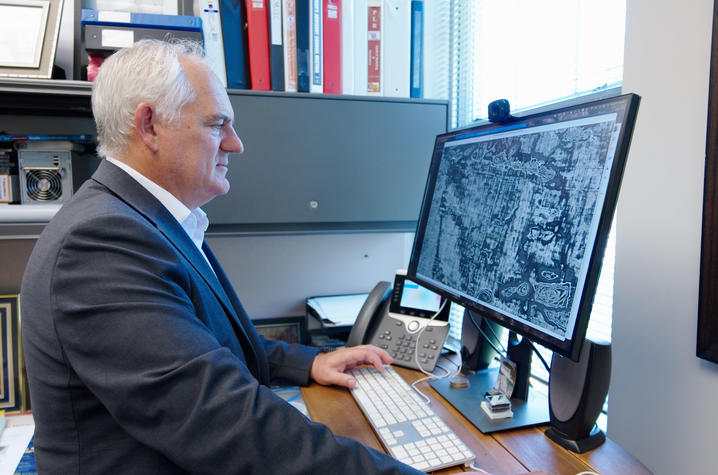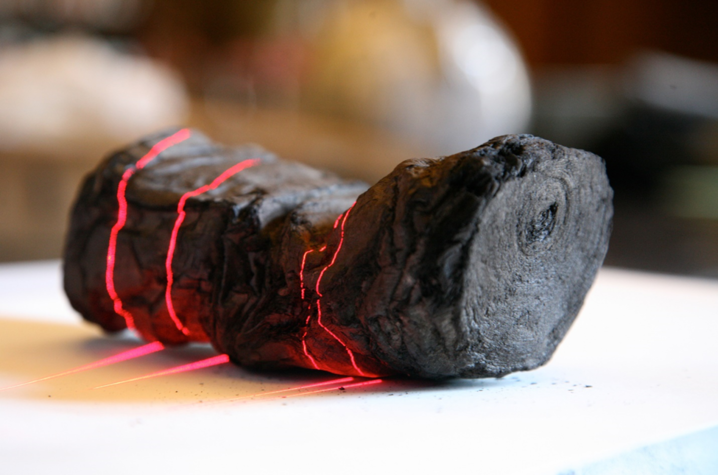Herculaneum scrolls: A 20-year journey to read the unreadable
LEXINGTON, Ky. (Aug.24, 2023) — Restoring an ancient library from the ashes of Mount Vesuvius is now closer to a reality. To highlight the progress, this is the first in a four-video series featuring Brent Seales, University of Kentucky Alumni Professor in the Department of Computer Science in the Stanley and Karen Pigman College of Engineering and his Digital Restoration Initiative team.
For more than two decades, Seales has been on a mission to unlock the secrets of the Herculaneum scrolls and other ancient artifacts. But thanks to machine learning and competition science, Seales believes they are closer than ever to reading text from the scrolls charred by volcanic eruption in 79 CE.
“Virtual unwrapping was born from a vision that I had where we might be able to explore the interior of something without having to physically open it,” Seales explained.
Virtual unwrapping takes a 3D X-ray from a micro-CT machine and pushes it through a step-by-step computerized process to find the ink and flatten the document so it can be read.
2009
In 2009, Seales and his team traveled to the Institut de France to perform the first-ever micro CT scans of completely sealed Herculaneum scrolls. The study provided the first ever volumetric images of a Herculaneum scroll, exposing the challenges ahead due to the complexity of the internal structure.
2015
In 2015, Seales and his research team used virtual unwrapping to read text from the ancient En-Gedi scroll, revealing it to be the beginning of the Book of Leviticus. It is believed to be one of the oldest Hebrew biblical texts ever found outside of the Dead Seas Scrolls.
2021
In 2021, the University of Kentucky announced a $14 million mid-scale infrastructure grant from the National Science Foundation, that allowed UK to build EduceLab. Seales gathered a team of experts from the College of Engineering and the College of Arts and Sciences for this collaborative user facility focused on developing innovative artificial intelligence (AI) solutions for heritage science — interdisciplinary scientific study of cultural or natural heritage.
Today
Launched earlier this year, a global competition is now underway to continue using artificial intelligence (AI) to read x-ray images of the unrolled Herculaneum papyri.
“The Vesuvius Challenge, which is a competitive prize, allowed us to enlist over a thousand research teams to work on a problem that normally we would only have five people working on," Seales said.
He says “competitive science,” the prize-based avenue of helping accelerate research, has proven extremely successful at speeding up progress.
Seales believes that if more of the writing from the Herculaneum scrolls can be extracted, it will be one of the biggest discoveries from the ancient world.
“I think there’s a huge emotional component that is powerful, and also can really inspire people to not only learn and apply the science, but to understand humanity’s history,” Seales said. “If I can play a role here at UK in bringing that to students and bringing that programmatically to what we do, that's what I want to do.”
Learn more about the Vesuvius Challenge here. Learn more about EduceLab here and the Digital Restoration Initiative here.


As the state’s flagship, land-grant institution, the University of Kentucky exists to advance the Commonwealth. We do that by preparing the next generation of leaders — placing students at the heart of everything we do — and transforming the lives of Kentuckians through education, research and creative work, service and health care. We pride ourselves on being a catalyst for breakthroughs and a force for healing, a place where ingenuity unfolds. It's all made possible by our people — visionaries, disruptors and pioneers — who make up 200 academic programs, a $476.5 million research and development enterprise and a world-class medical center, all on one campus.




